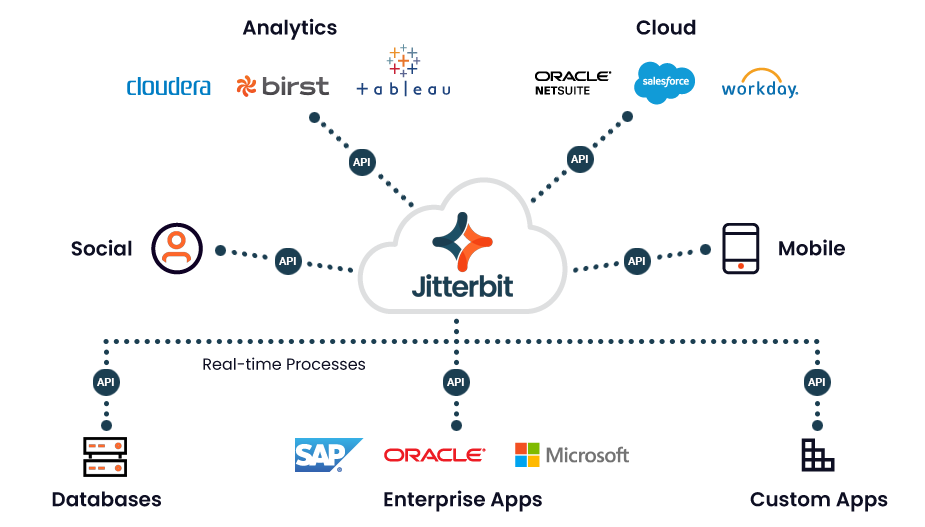Have you ever wondered how online restaurant reservations work? Or how mobile payments are processed so seamlessly? Or how your favorite online store can tell you what’s in stock immediately? It’s all APIs. Working behind the scenes, APIs and API integration are critical for just about every industry.
An API, short for Application Programming Interface, serves as a software bridge that enables applications to communicate with one another and securely share data. APIs, or application programming interfaces, function as intermediaries, receiving requests, translating them, and delivering appropriate responses between applications.
What is API integration?
API integration refers to this seamless connectivity that allows organizations to automate business processes, automate tasks, and enhance the sharing and embedding of data between various applications and different systems.
For example, an app like Tripadvisor aggregates data from various airlines and hotels by calling their APIs. Another example could be the syncing of leads between marketing automation systems such as Marketo with your CRM such as Salesforce so that Sales can work on them.
Today, API data integration is a necessity of modern enterprise IT. It is less a matter of if APIs are needed, but rather how many are necessary and how they will be created and published. To that end, companies now have many options at their disposal when it comes to creating and deciding how to integrate APIs.
But among all the choices, only one reigns supreme for its sheer speed and scalability: the API integration platform.
What is an API integration platform?
Recent data reveals more than 83% of enterprises use API integrations to increase ROI on their digital assets. API integration platforms have emerged as a user-friendly, scalable way to connect business apps and systems and automate complex workflows, enhancing productivity and operational efficiency.
A modern API integration platform, or an integration platform as a service (iPaaS), enables organizations of all sizes and all industries to integrate disparate systems and applications (such as CRM and ERP systems and ecommerce platforms) across on-premises and cloud environments. These platforms provide a centralized hub where APIs can be managed, orchestrated, and monitored, simplifying the process of building, deploying, and maintaining them.
With pre-built connectors, drag-and-drop interfaces, and real-time data synchronization, API integration platforms reduce the need for custom coding, speeding up the time to market for new integrations.
API Integration Examples by Industry
Finance & Banking
Many of today’s leading banks and financial institutions have been around for over a century, but that doesn’t mean they haven’t embraced 21st-century technology. As these institutions adopt mobile apps, digital payments, blockchain technology and more, APIs help to make all this a reality.
- Digital portals for online lending and investing rely on APIs to find nearby locations and exchange currencies.
- Peer-to-peer payment transfer apps like Venmo link to customer bank accounts through APIs.
- APIs make mobile banking possible, allowing customers to check their balance, pay bills, and transfer money between accounts quickly and securely from anywhere.
- Advanced analytics that help prevent fraud and predict future customer needs rely on APIs to gather data from various sources and databases.
Media & Publishing

While print is not dying, it has been declining for decades. To stay afloat, publishers and other media firms have embraced API-enabled technology to better meet the needs of today’s customers.
- Most online publishing platforms rely on APIs to receive content from publishers and creators.
- Content syndication is dependent on APIs, with major publishers like The New York Times using their own custom APIs.
- Many people use mobile devices like tablets, smartphones and e-readers to receive and see content, and APIs help to bring content from the publisher or creator directly to the consumer’s hardware.
Retail & E-commerce
In the retail sector, APIs enhance the customer experience by streamlining operations and improving efficiency.
- APIs help to connect point-of-sale (POS) systems with internal databases and bank-owned systems, and allow POS terminals accept payments from a variety of sources.
- Both brick and mortar stores and e-commerce sites use APIs to keep track of inventory, allowing customers to quickly see if items are in stock.
- APIs help customers and companies track shipments and stay on top of packages.
- APIs also underpin much of what happens inside a physical store, including software that handles employee scheduling and analytics solutions that help determine when to stock seasonal items.
Education
Today’s students are more likely to be familiar with tablets than they are with Scantrons. As technology permeates the classroom at all levels, educators increasingly rely on APIs to power their tools and lessons.

- Grades and tests are now all done online, and APIs connect answers and scores to central databases for storage and analysis.
- As computers replace attendance rolls, student profiles, directories and other necessary housekeeping information, APIs ensure that software used always has the most accurate information.
- In higher education, signing up for classes is now as easy as making a restaurant reservation or finding flight deals. APIs connected to these kinds of platforms provide students with up-to-date information on which classes have space for them and prerequisites.
- APIs also help teachers share lesson plans and develop curriculum collaboratively, powering file-sharing software and digital collaboration.
Healthcare
From diagnoses and care to billing and insurance, APIs are helping to power significant changes throughout healthcare.
- API-enabled databases of diseases and symptoms make it easier for doctors to diagnose patients, while electronic health records allow medical facilities to keep track of vaccine records and previous tests.
- Online portals powered by APIs make it easy for patients to find in-network care providers and book appointments.
- In medical facilities, APIs help administrators see where open beds are located and if a patient needs additional care before discharge.
- API technology enables care providers to seamlessly transmit billing and care data to insurers, allowing insurers to bill more accurately and consistently.
- APIs also help to alleviate potential non-compliance concerns, allowing all medical data transfers to be protected and critical information to be easily retrieved.
Manufacturing

Manufacturers have been quick to embrace new technologies like robotics and automation, and APIs make much of this new technology possible.
- API tech allows manufacturers to effectively track and oversee every process from start to finish.
- Through APIs, manufacturers can track incoming parts and outgoing final goods more effectively, allowing them to spot potential supply chain disruptions before they happen.
- On an administrative level, API connectivity can better guarantee accurate accounts receivable and accounts payable, and link together the financial records of many supply chain partners.
- API-facilitated oversight makes compliance easier too, helping to ensure that conflict minerals remain outside the supply chain and that sanctions and international law are followed to the letter.
Recommended Reading: Manufacturing Data Integration: Benefits, Challenges, and Best Practices
10 Benefits of API Integration Platforms
API integration platforms accelerate digital growth and efficiency across your organization by:
1. Easily Connect Cloud Apps
Hundreds, if not thousands, of cloud apps exist today. This technology has firmly permeated the enterprise. However, SaaS sprawl has now become a prevalent issue for enterprises across the globe, with recent data revealing the average SaaS portfolio now comprises 315 apps — and this number will only continue to grow.
When it comes to connecting cloud apps, API integrations are now the standard. Most legacy integration technology, like enterprise service buses (ESBs), was designed in the on-premise era and struggled to support modern API connectivity beyond the firewall. The gravity of apps has shifted to the cloud, and it no longer makes sense to house the platform that connects all these clouds behind your firewall. Simply put, an API integration platform born in the cloud, like Jitterbit’s API Manager, is necessary to connect today’s modern cloud APIs.
2. Combine Apps to Solve Unique Business Problems
Think about the typical finance department at your average enterprise. Consider all the tasks that fall on these teams. Everything from accounts payable, billing, taxes, insurance payouts, and more is under their purview. While there are some tools out there that claim to do everything an average finance department would need, that solution is likely both expensive and not very good at all of these tasks.
Instead, many departments—including 96% of account and finance teams—are using API integration platforms and tools to build their own solutions, assembling their own customized workflows by pulling together best-of-breed solutions that handle specific tasks and data sets. With an API integration platform, departments are able to easily connect the best apps and tools available. This way, they can replace all-encompassing yet inadequate options with a sleek and highly effective stack.
3. Speed Up API Integration for Faster ROI
Until recently, if you needed to integrate a new platform or data source, you had two main options. You either used what was already available (i.e., what SaaS platforms and vendors or another third party already made), or you built one from scratch. Both scenarios present their own challenges. Assuming an integration solution is available from an outside source, it could be limited in its functionality or use. Building one from scratch via code is not ideal either, as that is typically a time-consuming and difficult task.
By definition, an Integration Platform as a Service (iPaaS) platform offers an easier option. With just the click of a few buttons, you can create API data integrations from existing systems, saving you time and money while also fully leveraging your existing technology investments.
4. Connect Existing and Legacy Data Sources
At many companies, especially older ones, data that is more than a year or even a few months old just ends up on a database somewhere. It’s “collecting dust,” remaining relatively dormant. Part of the reason older data often remains underutilized is that it can be difficult to access and subsequently integrate into current systems.
An API integration platform allows businesses to create their own integration solutions just for internal use, making it easier to extract and share data from older servers and databases as well as reuse business processes, logic, and workflows that are already working.
5. Build New Apps Using Multiple APIs
Fun fact: When Facebook purchased Instagram in 2012, the photo-sharing social network had only 13 employees. Instagram is not necessarily an outlier here, either. After all, WhatsApp had 55 staff members in 2014 when it was bought by Facebook. How were these companies able to create enormously successful apps with such small teams?
API integrations. That’s how.
Many popular apps, at their core, consist of previously existing technology that is tied together in a unique fashion using API integration. Photo filters and social media technology existed before Instagram, but they were able to package them together in a different way through integration.
New apps can be composed in the exact same way. Through the use of an API integration platform, teams can quickly and simply connect disparate technology or expose existing integrations as APIs or microservices to bring new apps to market.
6. Free Up Development Resources
At organizations where successful API integration creation involves manual processes, they then have to employ a team of developers and other IT staff to get everything up and running. Similarly, enterprise departments that lack concrete, integrated stacks often hire staff members specifically to handle one or two apps.
With an API integration platform in place, not only can that team of developers focus their efforts elsewhere on strategic projects (say, composing new revenue-generating apps, for instance), but often fewer people are needed to keep every department productive.
7. Improve Team Productivity
For developers, coders and other members of the IT department, automating connectivity between applications and data sources via API integrations serve as a huge boon to productivity. The hours every month that would previously be spent creating, managing, overseeing and fixing APIs can instead be devoted to other pursuits.
API integration platforms provide similar benefits to other enterprise departments, too. Not only does this technology enable stacks to become a reality, but such platforms often empower even teams lacking technical skills to create and manage their own API integrations if desired.
8. Save Time Managing One Unified Platform
When it comes to manual API integration methods (even if the API integration itself was created by a third party), oversight and maintenance of the integration still falls on developers or other IT staff members in the enterprise system. As API integration use cases skyrocket, keeping tabs on all the software systems in place can be an exhausting and time-consuming effort.
API integration platforms can significantly reduce this administrative burden. By serving as a single pane of glass for all deployed and created APIs, these tools simplify API management, security, and monitoring of complex business processes.
9. Gain Access to Outside API Integration Experts
Whether self-created or third-party API integrations are in use, businesses typically have no one to turn to for help. API integrations made by outside parties might offer user guides and documentation, but it can be difficult to get one-on-one support.
API integration platform providers often have in-house experts that can be called upon if necessary. This level of support can go a long way toward ensuring that a business is getting the most out of all of its API integrations and other IT investments.
10. Futureproof Your Enterprise
Technology has progressed at a rapid clip over the past decade, and this growth shows no signs of slowing down. Artificial Intelligence (AI) and the Internet of Things (IoT) are just some of the tech trends poised to dramatically change the enterprise IT landscape in the future.
With an API integration platform in place, organizations can be sure they have the tools to effectively integrate new technology as they evolve and expand.
To get comprehensive insights into the API integration landscape, download the State of API Integration report.
The insights collected from this survey are intended to help you anticipate business technology trends, compare and implement strategies with your peers, and better prepare your business for digital transformation.
Try Jitterbit’s iPaaS Solution for API Integration
Integrate your SaaS, on-premise, and cloud applications in just days with our low-code iPaaS platform. With intuitive drag-and-drop functionality and pre-built connectors, you can effortlessly streamline workflows and automate processes from start to finish—click the link below to request your demo of our API integration platform.



